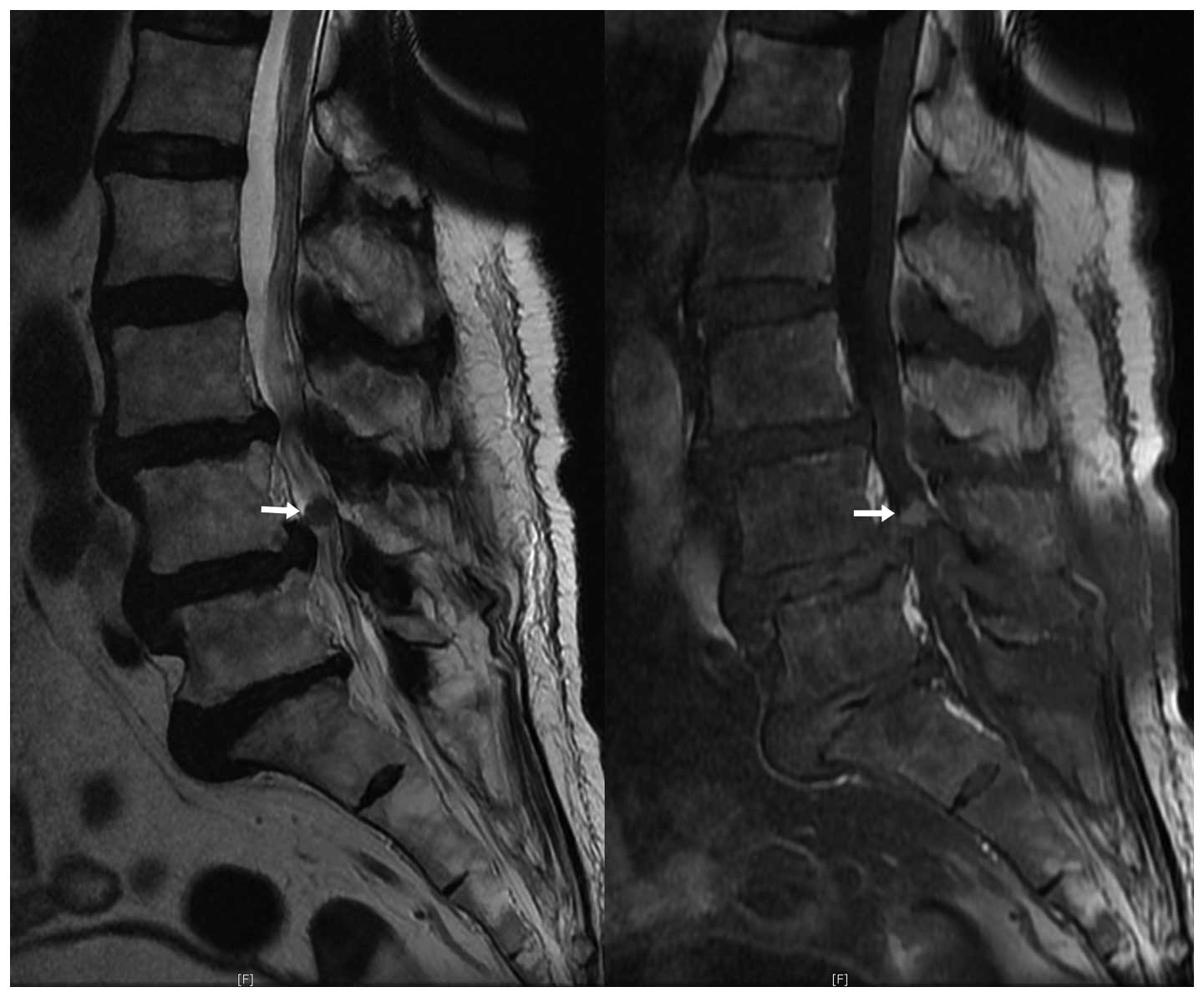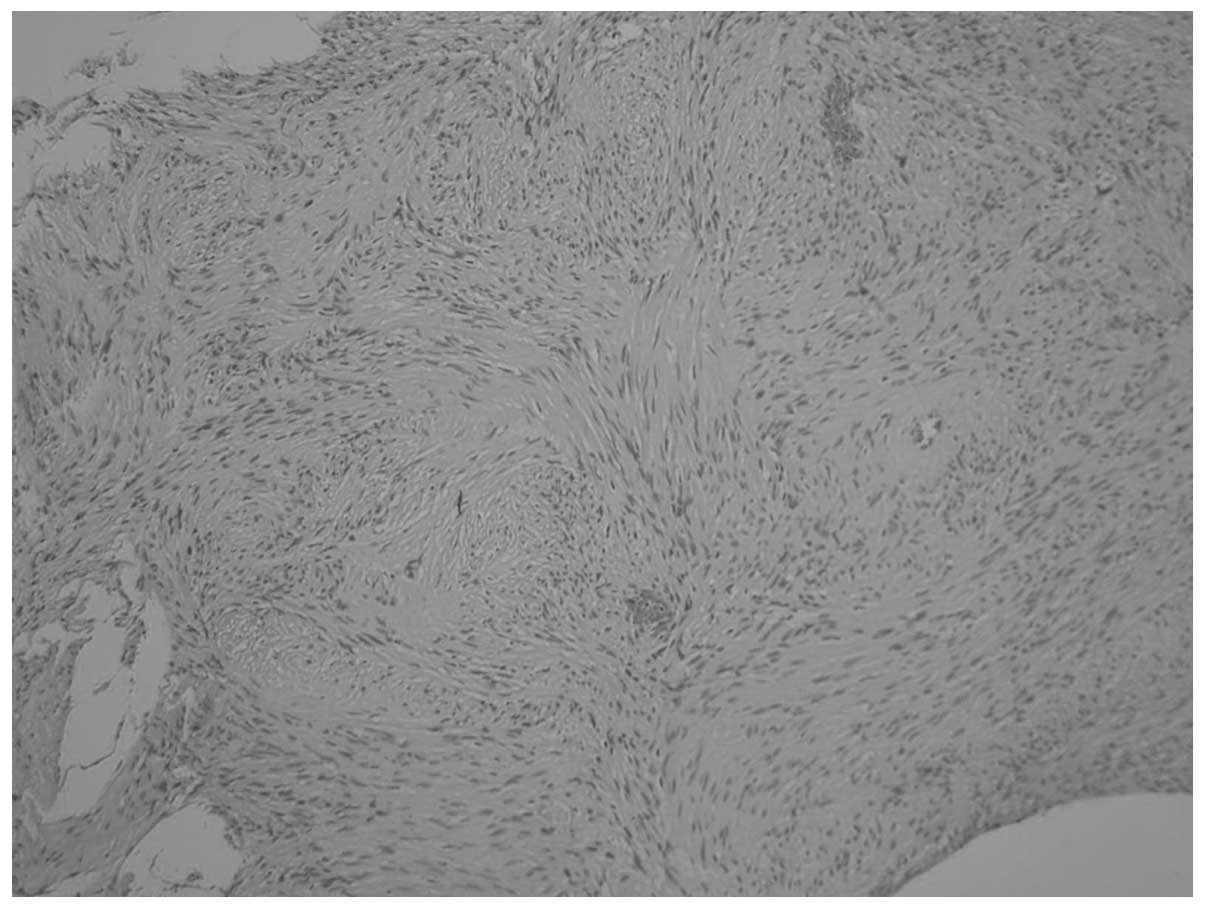Intradural schwannoma complicated by lumbar disc herniation at the same level: A case report and review of the literature
- Authors:
- Seung‑Wook Baek
- Cheol Kim
- Han Chang
View Affiliations
Affiliations: Department of Orthopaedic Surgery, Spine Center, Busan Korea Hospital, Busan 608-811, Republic of Korea
- Published online on: May 26, 2014 https://doi.org/10.3892/ol.2014.2181
-
Pages:
936-938
Metrics: Total
Views: 0 (Spandidos Publications: | PMC Statistics: )
Metrics: Total PDF Downloads: 0 (Spandidos Publications: | PMC Statistics: )
This article is mentioned in:
Abstract
Intradural tumours of the spine are usually benign and have a good prognosis, if they are diagnosed and removed early. Lumbar disc herniation is a common cause of chronic, acute, or recurrent lumbar radiculopathy. However, to date, there have been no reports of progressive neurological deficiencies due to the co‑existence of two significant pathologies contributing to intradural and extradural compression. The current study reports the rare case of a patient with simultaneous extradural and intradural compression of the nerve root due to co‑existent intervertebral disc herniation and an intradural schwannoma at the same level. A 71‑year‑old female suffering from lower back pain and radiating pain of the right lower extremities was admitted to Busan Korea Hospital (Busan, Korea). Magnetic resonance imaging revealed lumbar disc herniation at L4‑5 and a mass occupying the intradural space at the same level of the compressed dural sac. Using the posterior approach, surgical excision of the two pathologies was performed. Pathological diagnosis confirmed schwannoma and the symptoms markedly improved.
View References
|
1
|
Frymoyer JW: Back pain and sciatica. N
Engl J Med. 318:291–300. 1988.
|
|
2
|
Ellenberg MR, Ross ML, Honet JC, et al:
Prospective evaluation of the course of disc herniation in patients
with proven radiculopathy. Arch Phys Med Rehabil. 74:3–8. 1993.
|
|
3
|
Shapiro S: Medical realities of cauda
equina syndrome secondary to lumbar disc herniation. Spine.
25:348–351. 2000.
|
|
4
|
McCormick PC, Post KD and Stein BM:
Intradural extramedullary tumors in adults. Neurosurg Clin N Am.
1:591–608. 1990.
|
|
5
|
Sloof JL, Kernohan JW and MacCarty CS:
Primary Intramedullary Tumours of the Spinal Cord and Filum
Terminale. WB Saunders; Philadelphia: pp. 31–61. 1964
|
|
6
|
Takeuchi A, Miyamoto K, Hosoe H and
Shimizu K: Thoracic paraplegia due to missed thoracic compressive
lesions after lumbar spinal decompression surgery: report of three
cases. J Neurosurg. 100:71–74. 2004.
|
|
7
|
Wiesel SW, Ignatius P, Marvel JP Jr and
Rothman RH: Intradural neurofibroma simulating lumbar-disc disease.
Report of six cases. J Bone Joint Surg Am. 58:1040–1042. 1976.
|
|
8
|
Van Goethem JW, van den Hauwe L, Ozsarlak
O, De Schepper AM and Parizel PM: Spinal tumors. Eur J Radiol.
50:159–176. 2004.
|
|
9
|
Sevick RJ: Cervical spine tumors.
Neuroimaging Clin N Am. 5:385–400. 1995.
|
|
10
|
Caputo LA and Cusimano MD: Schwannoma of
the cauda equina. J Manipulative Physiol Ther. 20:124–129.
1997.
|
|
11
|
Crnalic S, Hildingsson C, Wikström P,
Bergh A, Löfvenberg R and Widmark A: Outcome after surgery for
metastatic spinal cord compression in 54 patients with prostate
cancer. Acta Orthop. 83:80–86. 2012.
|
|
12
|
Kagaya H, Abe E, Sato K, Shimada Y and
Kimura A: Giant cauda equina schwannoma. A case report. Spine
(Phila Pa 1976). 25:268–272. 2000.
|
|
13
|
Bradley WG: Use of contrast in MR imaging
of the lumbar spine. Magn Reson Imaging Clin N Am. 7:439–457.
vii1999.
|












